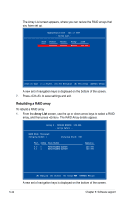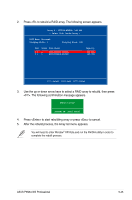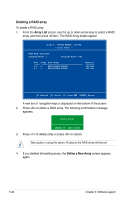Asus P5N64 User Guide - Page 149
Nvidia
 |
UPC - 610839162086
View all Asus P5N64 manuals
Add to My Manuals
Save this manual to your list of manuals |
Page 149 highlights
5.4.2 NVIDIA® RAID configurations The motherboard includes a high performance SATA RAID controller integrated in the NVIDIA® nForce® 790i Ultra SLI™ chipset. It supports RAID 0, RAID 1, RAID 10, and RAID 5 for six independent Serial ATA channels. Installing Serial ATA (SATA) hard disks The motherboard supports Ultra DMA 133/100/66 and Serial ATA hard disk drives. For optimal performance, install identical drives of the same model and capacity when creating a disk array. To install the SATA hard disks for a RAID configuration: 1. Install the SATA hard disks into the drive bays. 2. Connect the SATA signal cables. 3. Connect a SATA power cable to the power connector on each drive. Refer to the RAID controllers user manual in the motherboard support DVD for detailed information on RAID configurations. See section 5.2.5 Manuals menu. Setting the BIOS RAID items After installing the hard disk drives, make sure to set the necessary RAID items in the BIOS before setting your RAID configuration. To set the BIOS RAID items: 1. Boot the system and press during the Power-On Self-Test (POST) to enter the BIOS Setup Utility. 2. Go to Main > IDE Configuration and enable the nVidia RAID Function item in the BIOS. See section 4.3.7 IDE Configuration for details. 3. Enable the SATA 1/2/3/4/5/6 drive(s) that you want to configure as RAID. See section 4.3.7 IDE Configuration for details. 4. Save your changes and Exit Setup. Make sure to re-enter your NVRAID settings after the CMOS is cleared; otherwise, the system will not recognize your RAID setup. For detailed descriptions on the NVIDIA® RAID configuration, refer to the NVIDIA RAID User Guide found in your motherboard support DVD. ASUS P5N64 WS Professional 5-41















